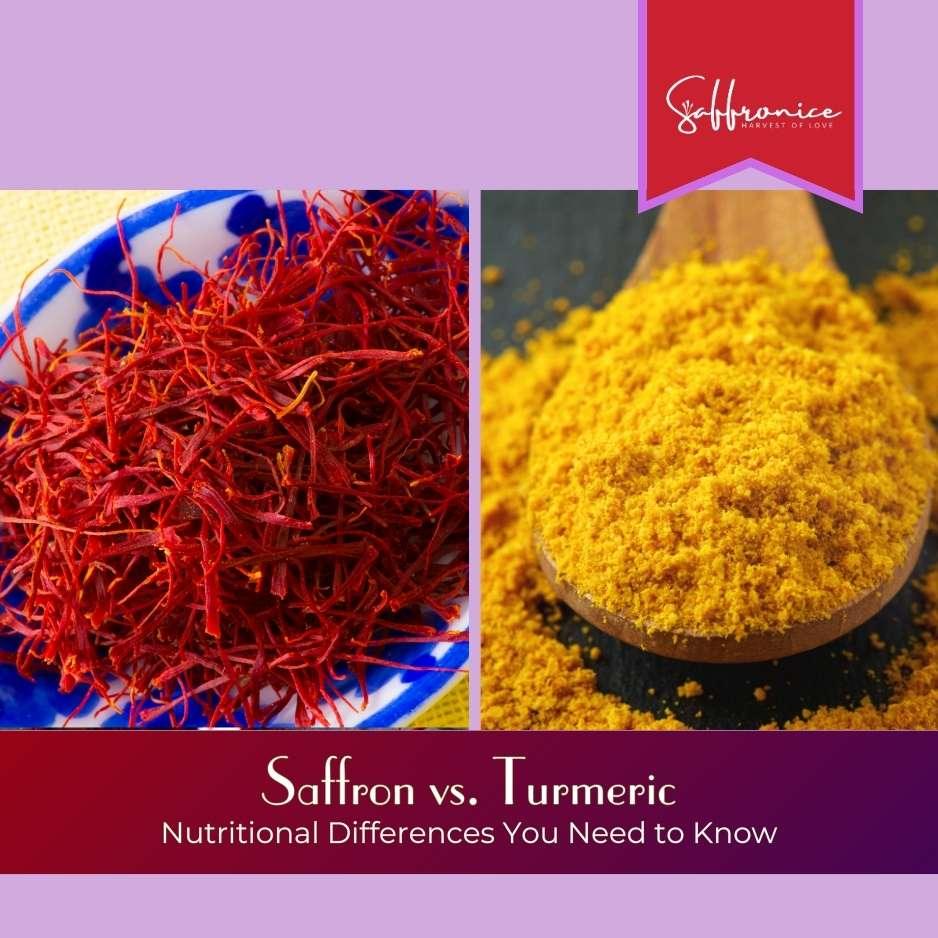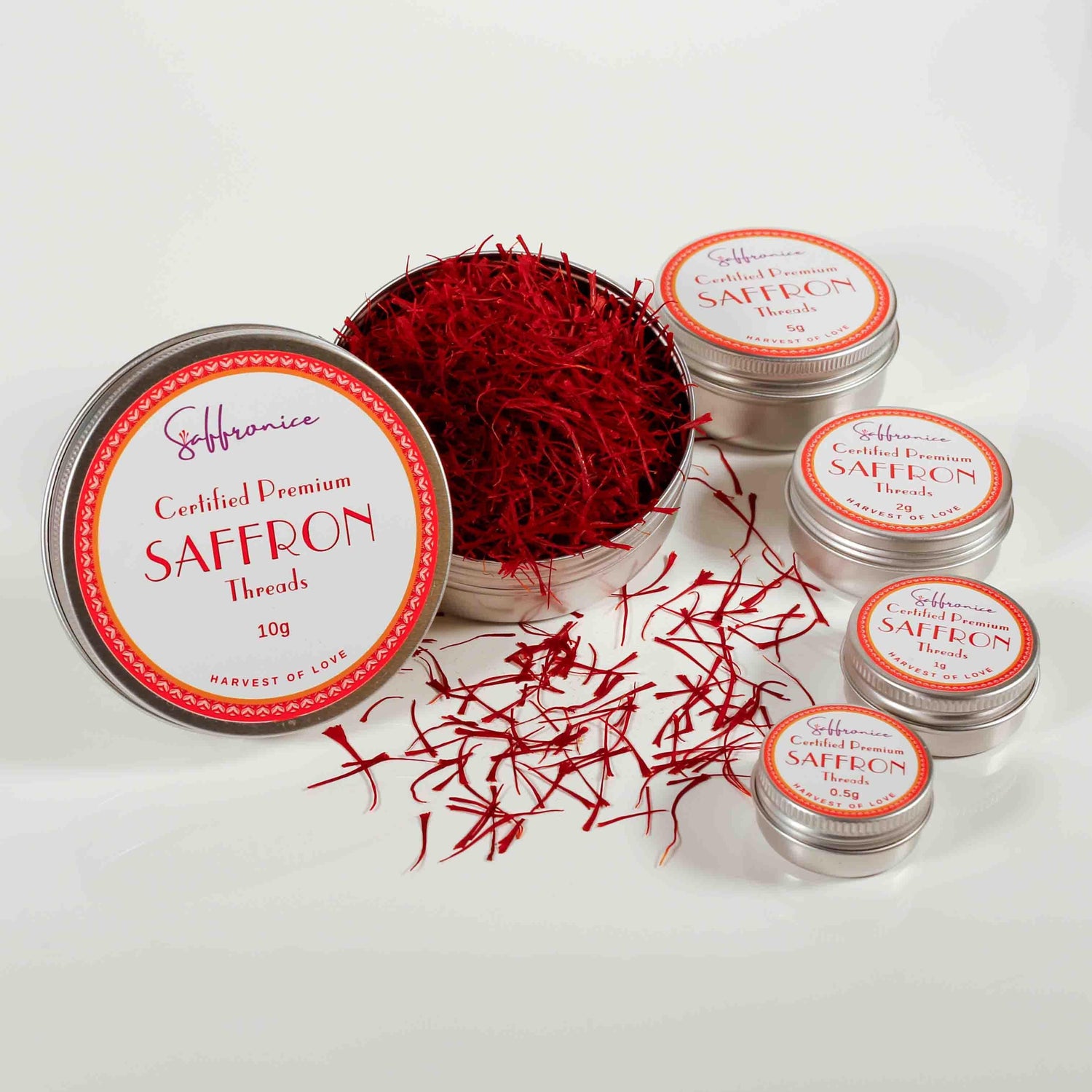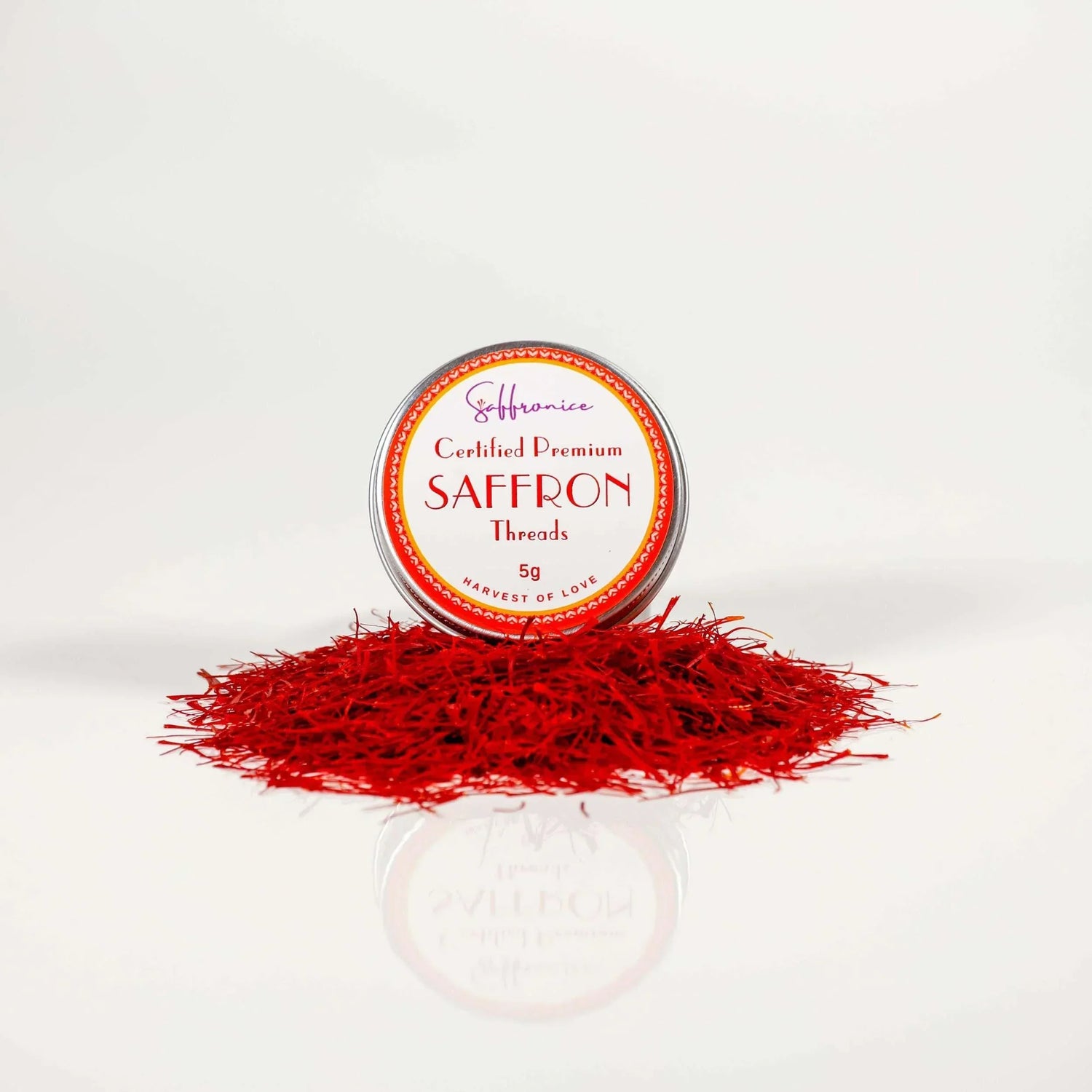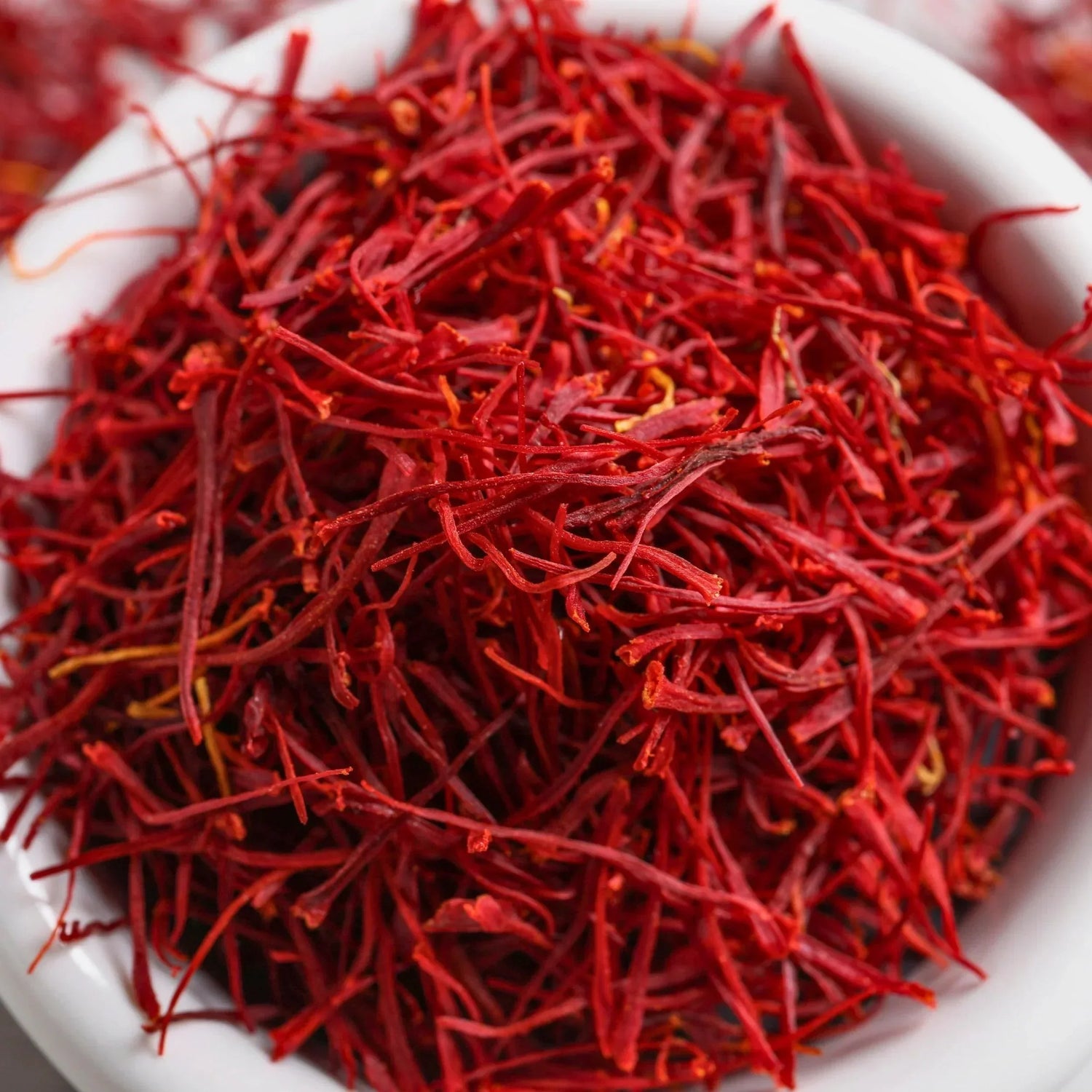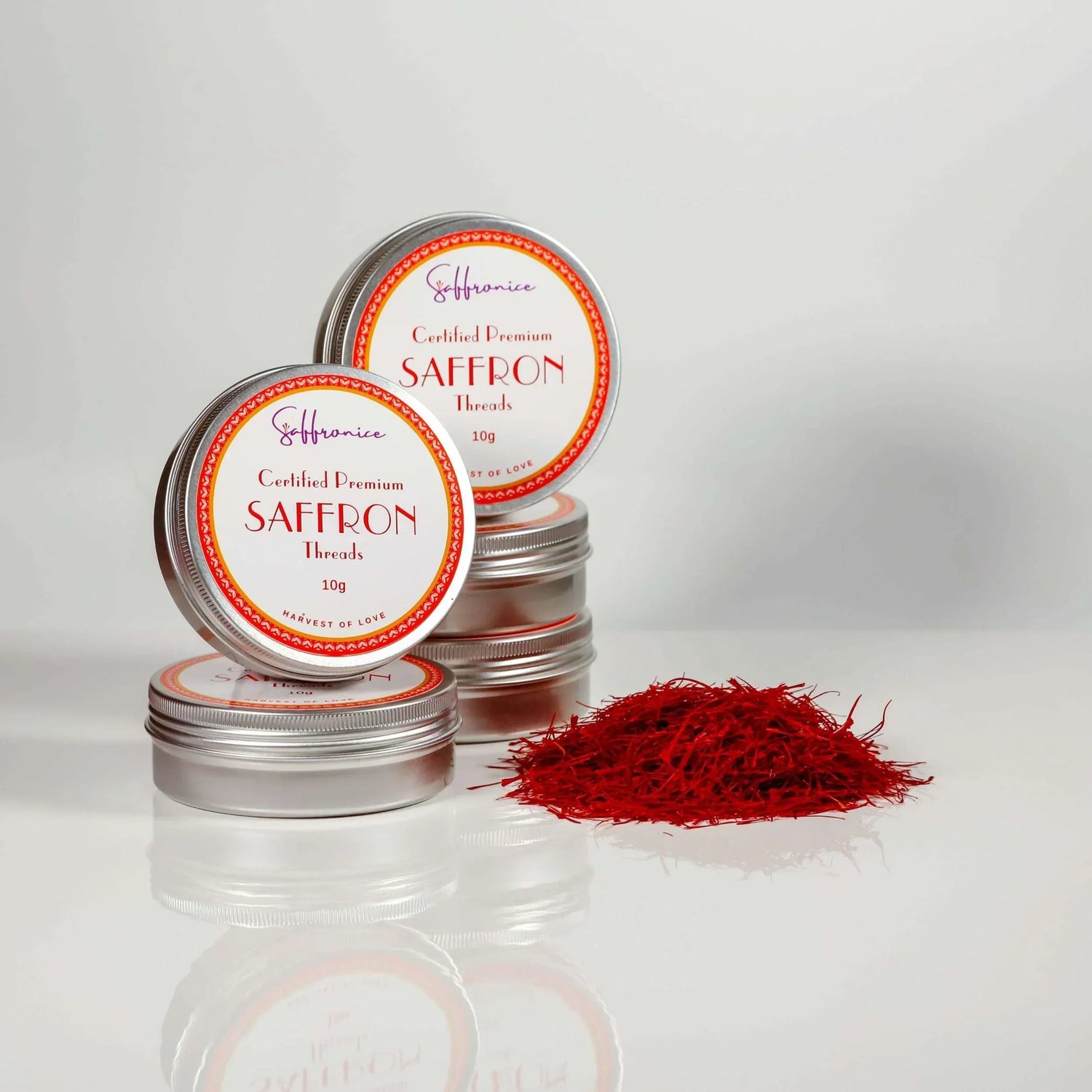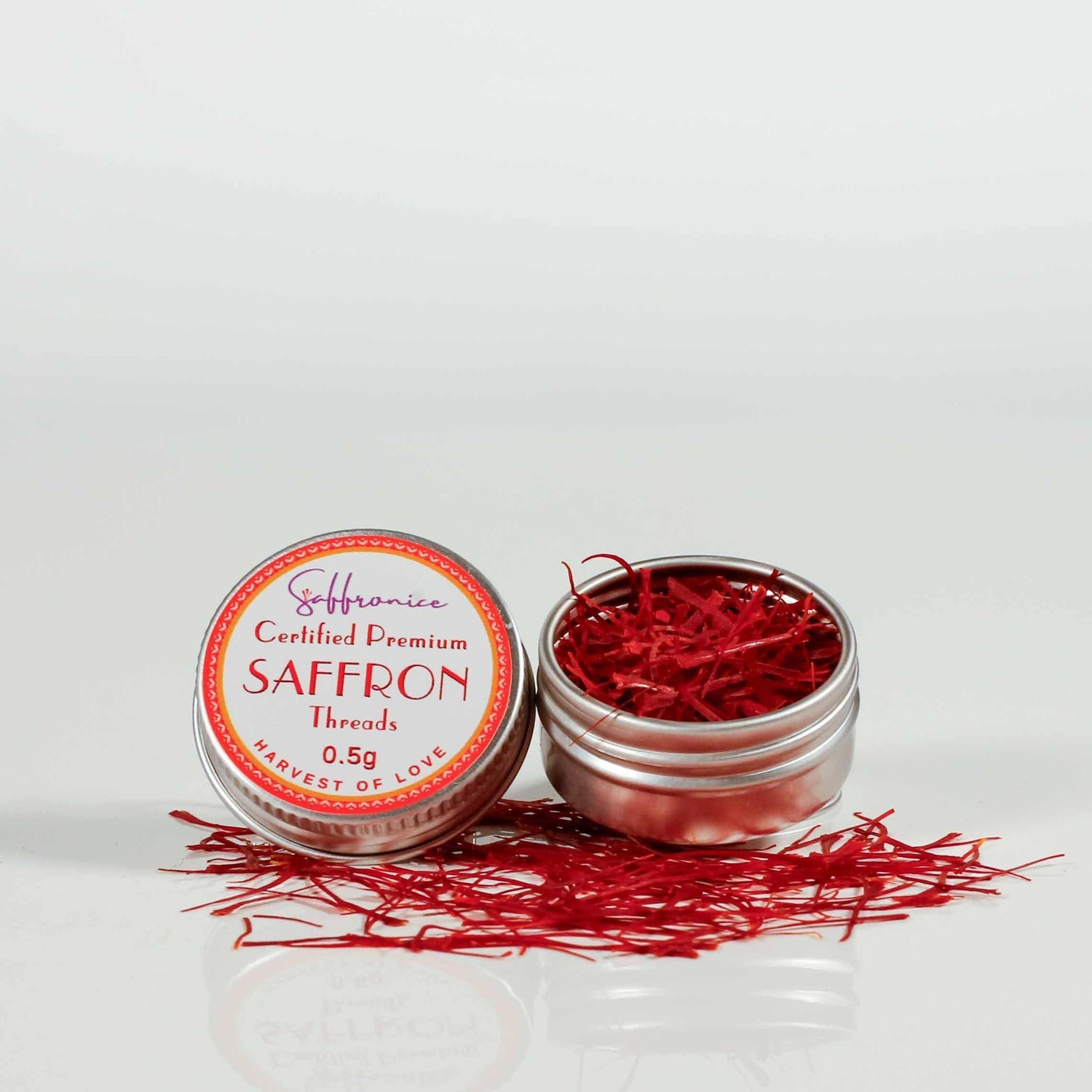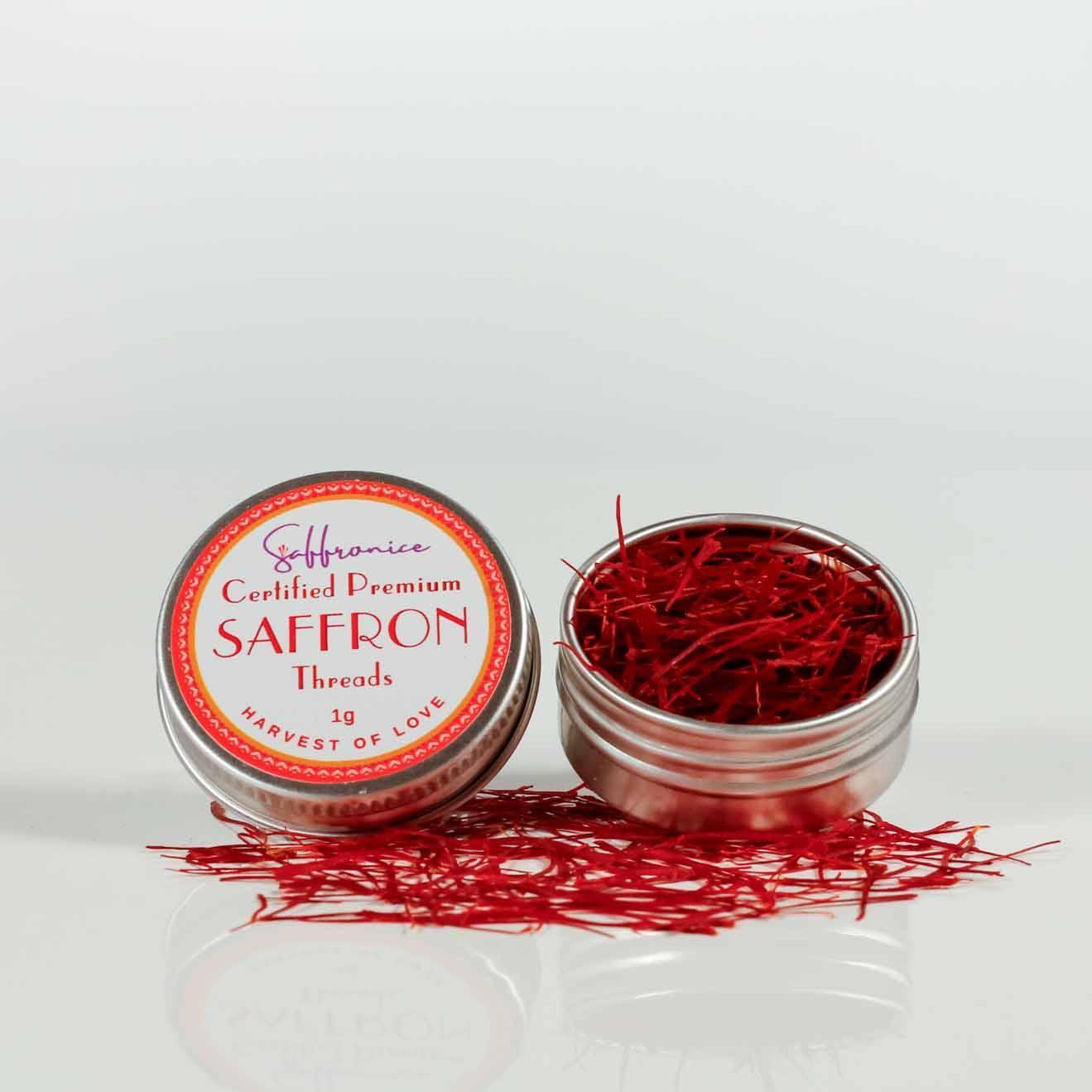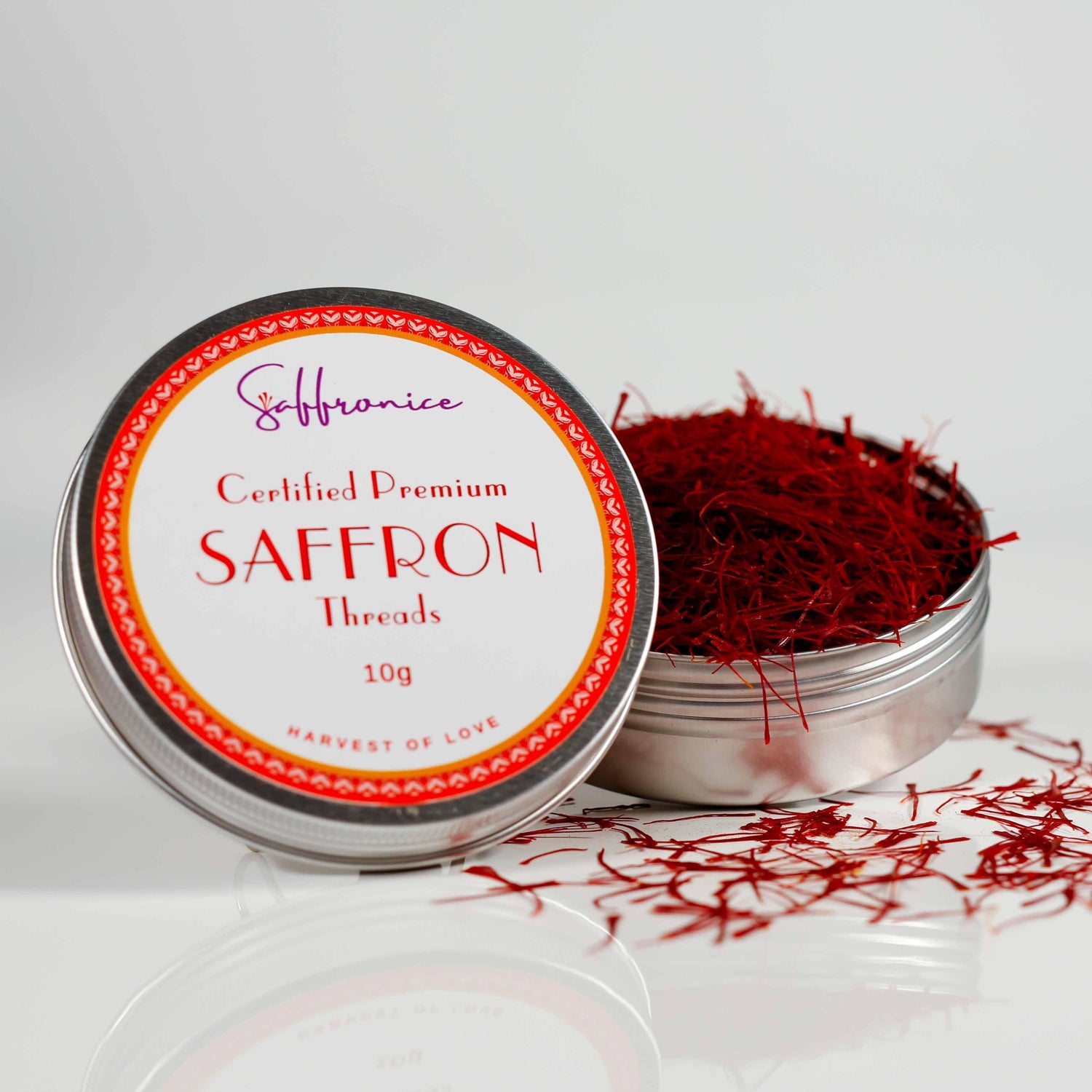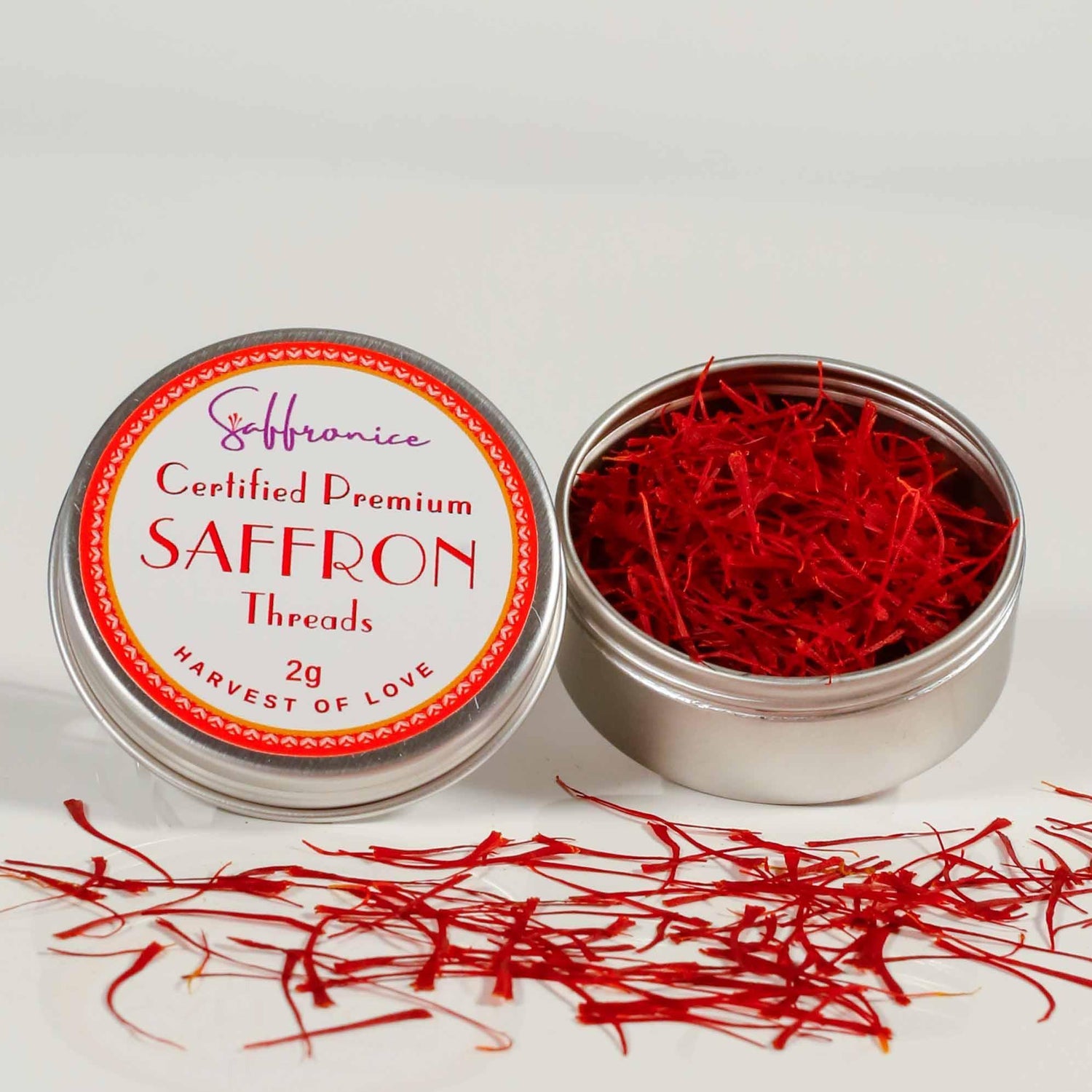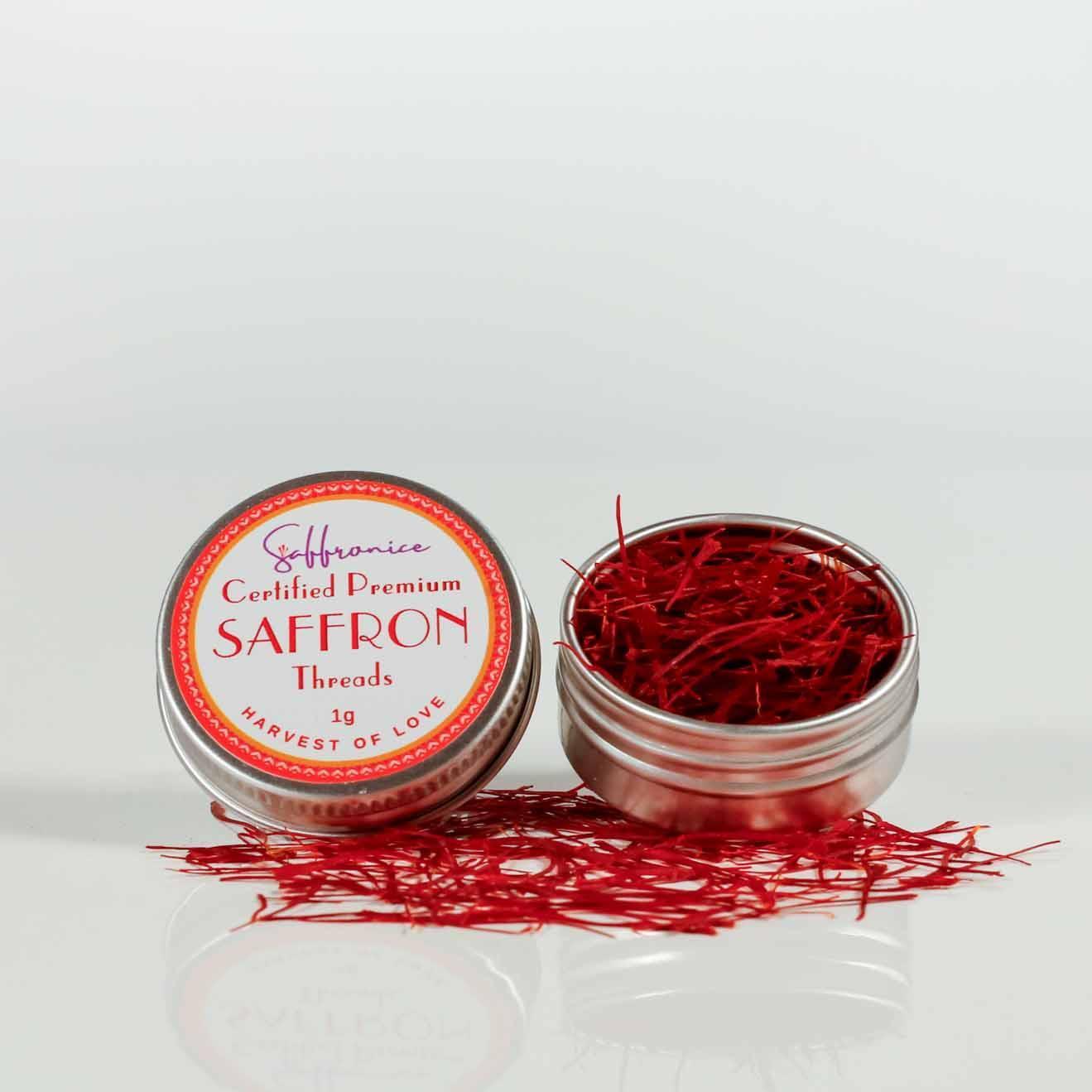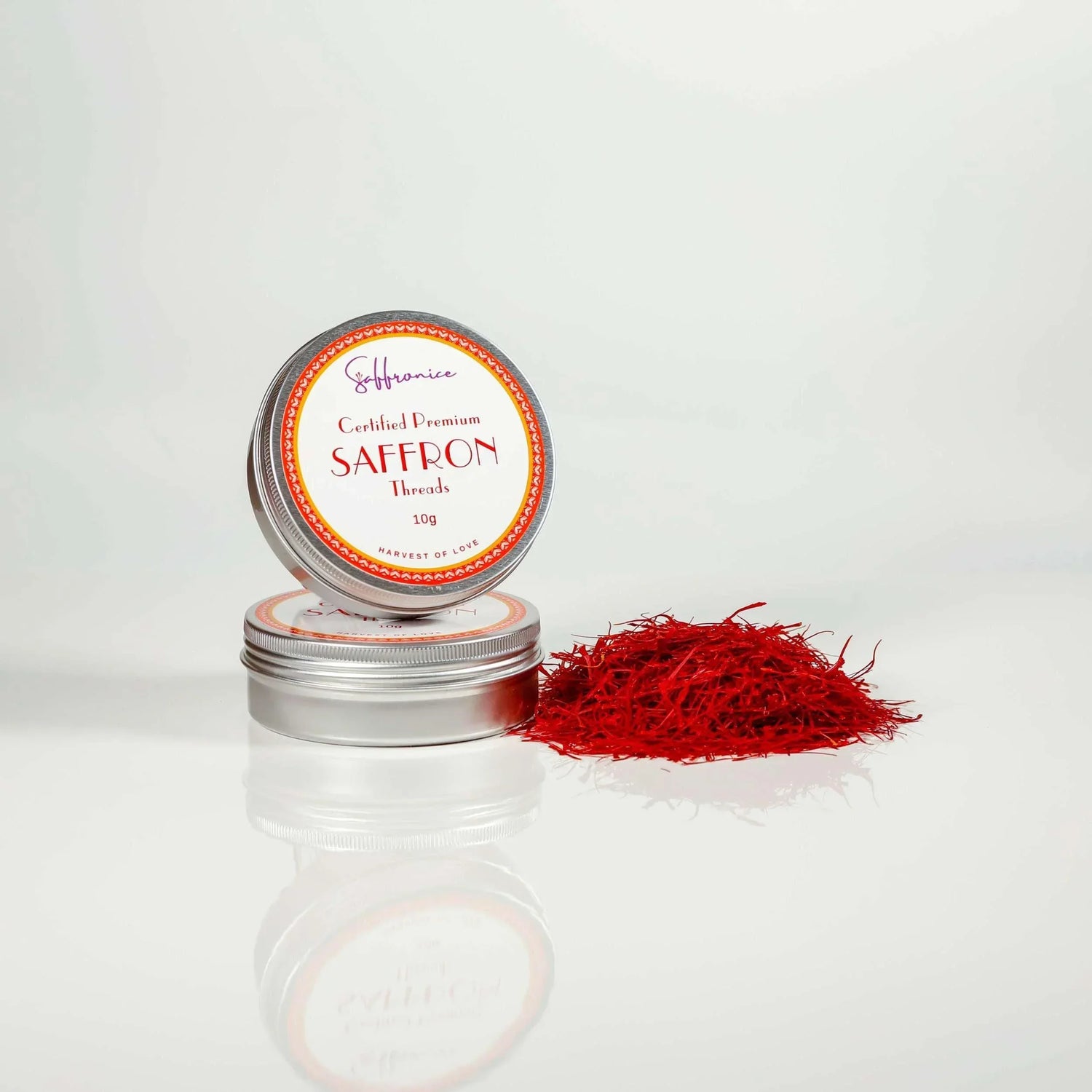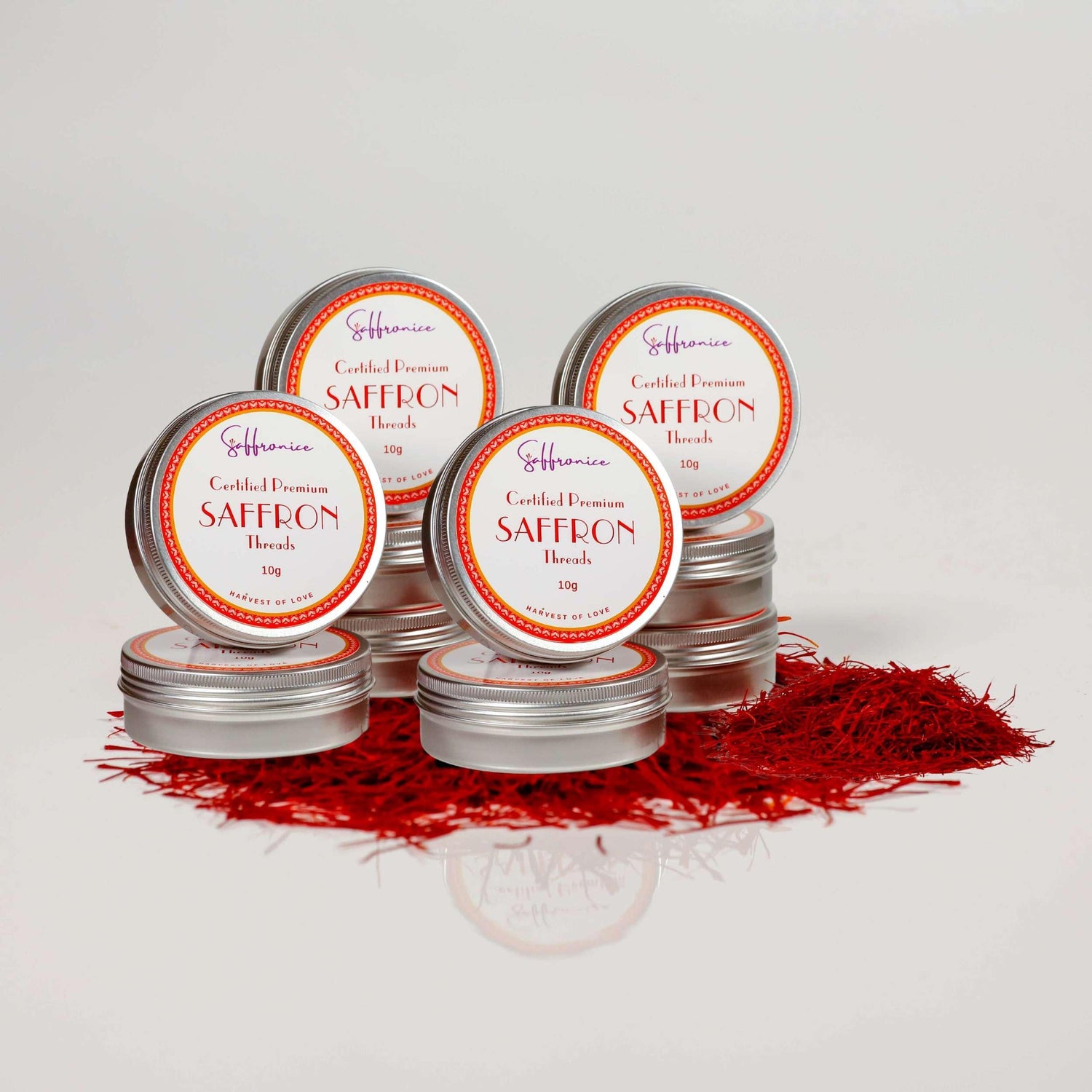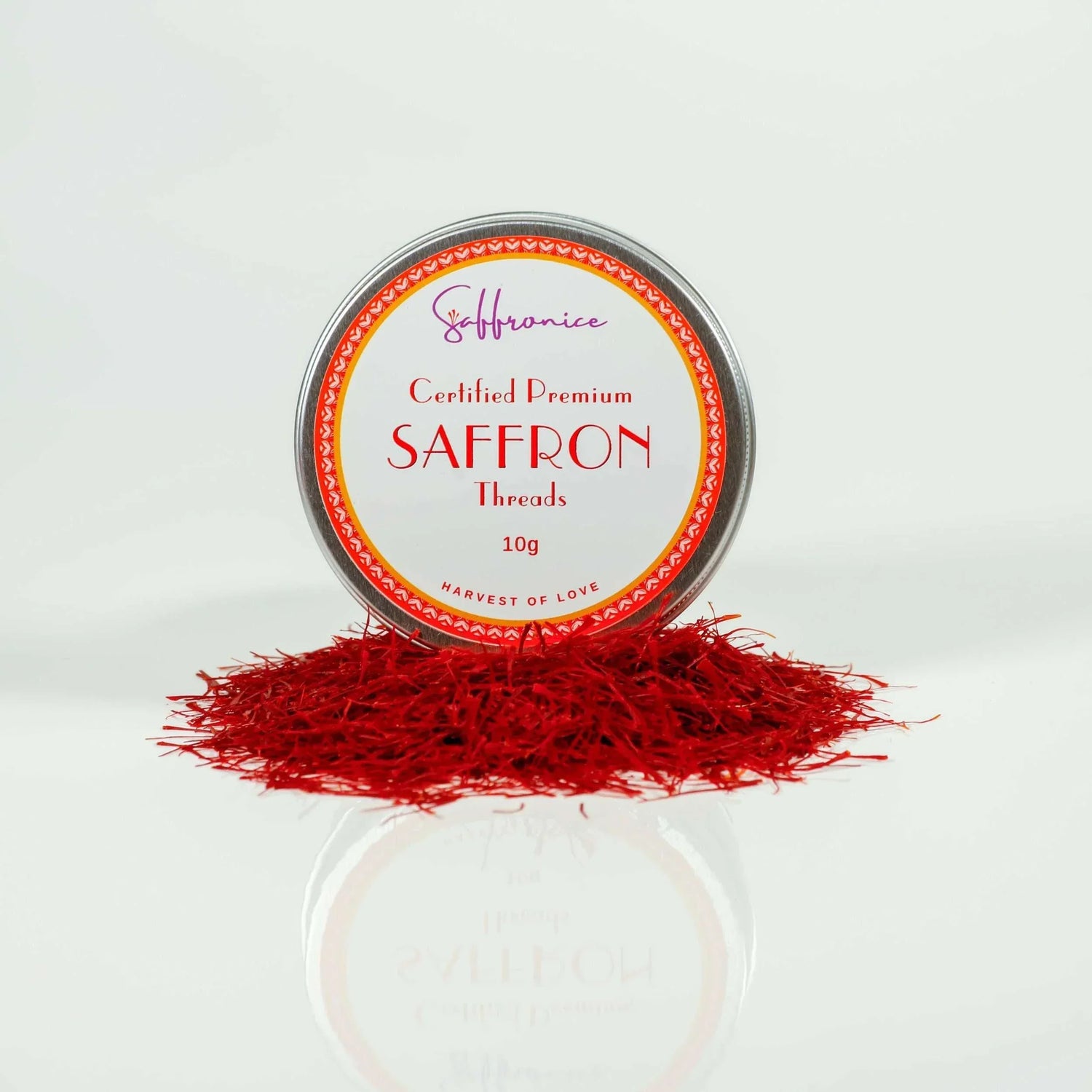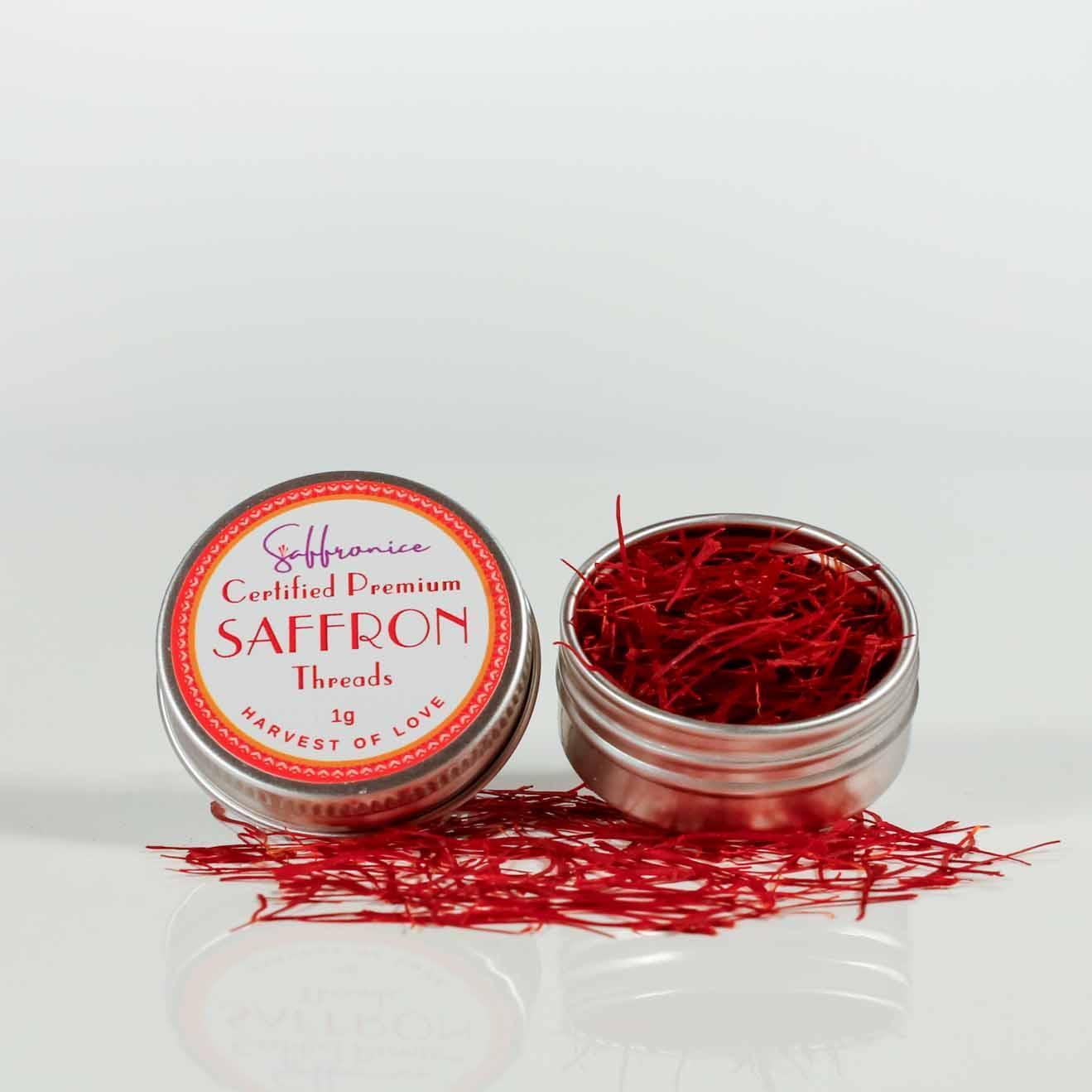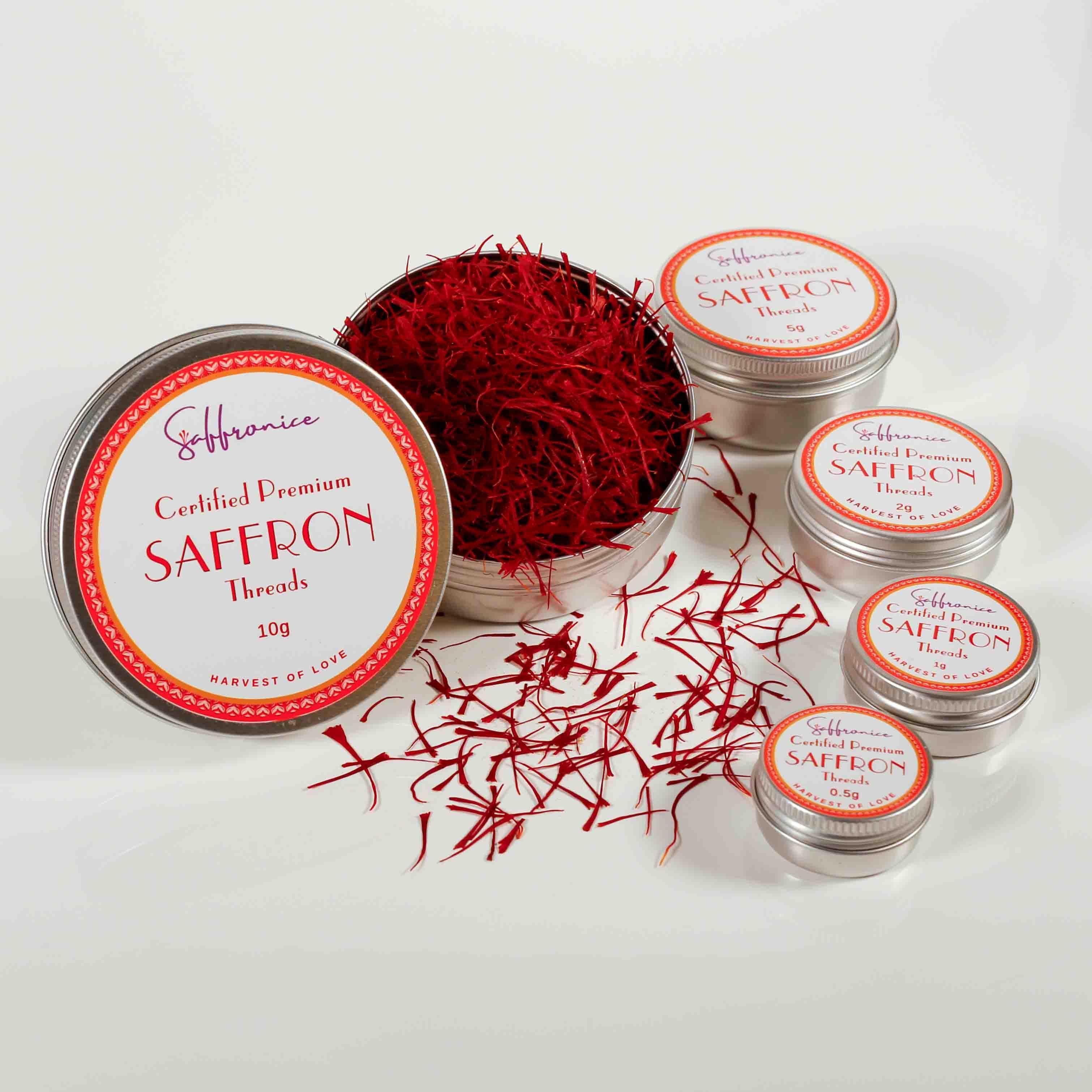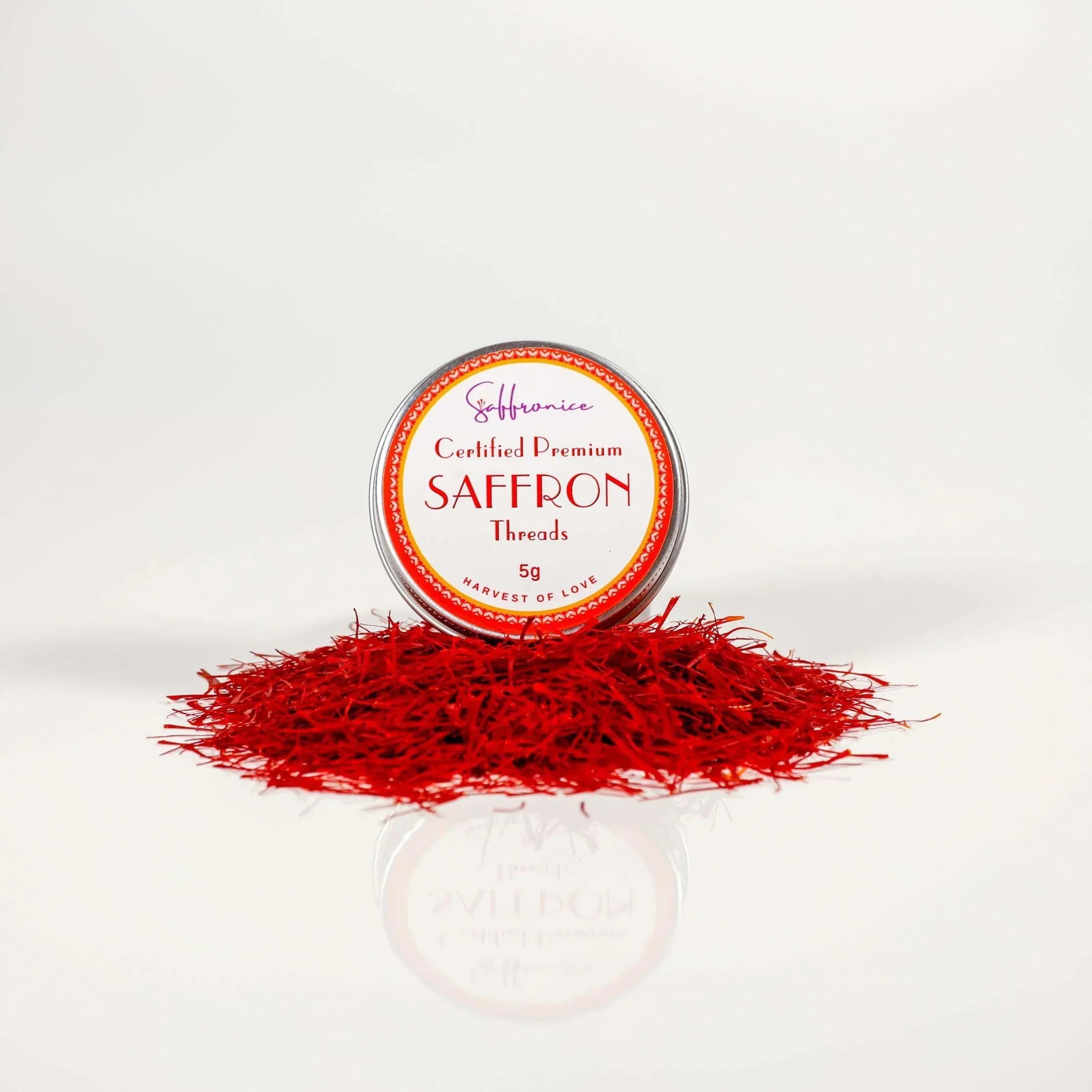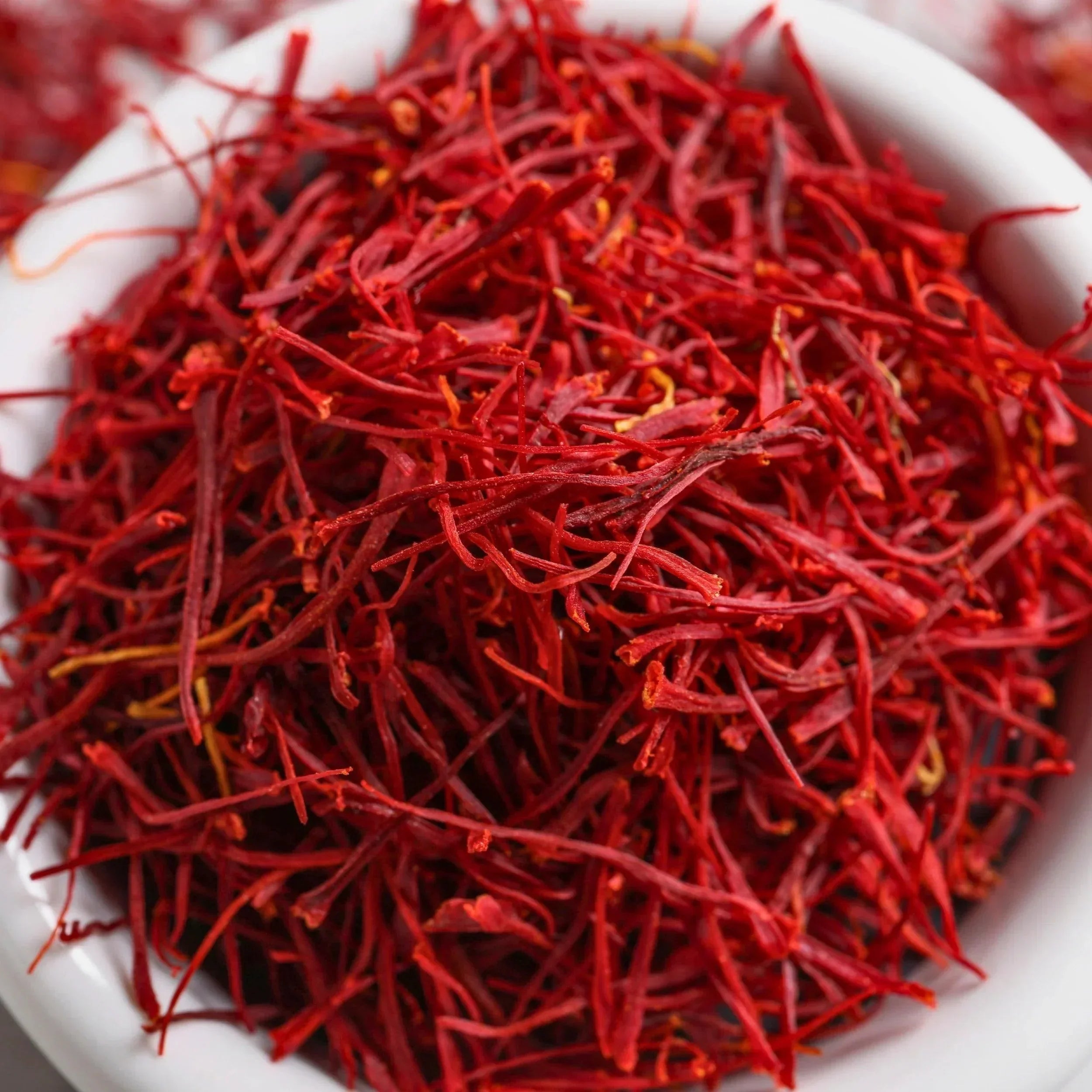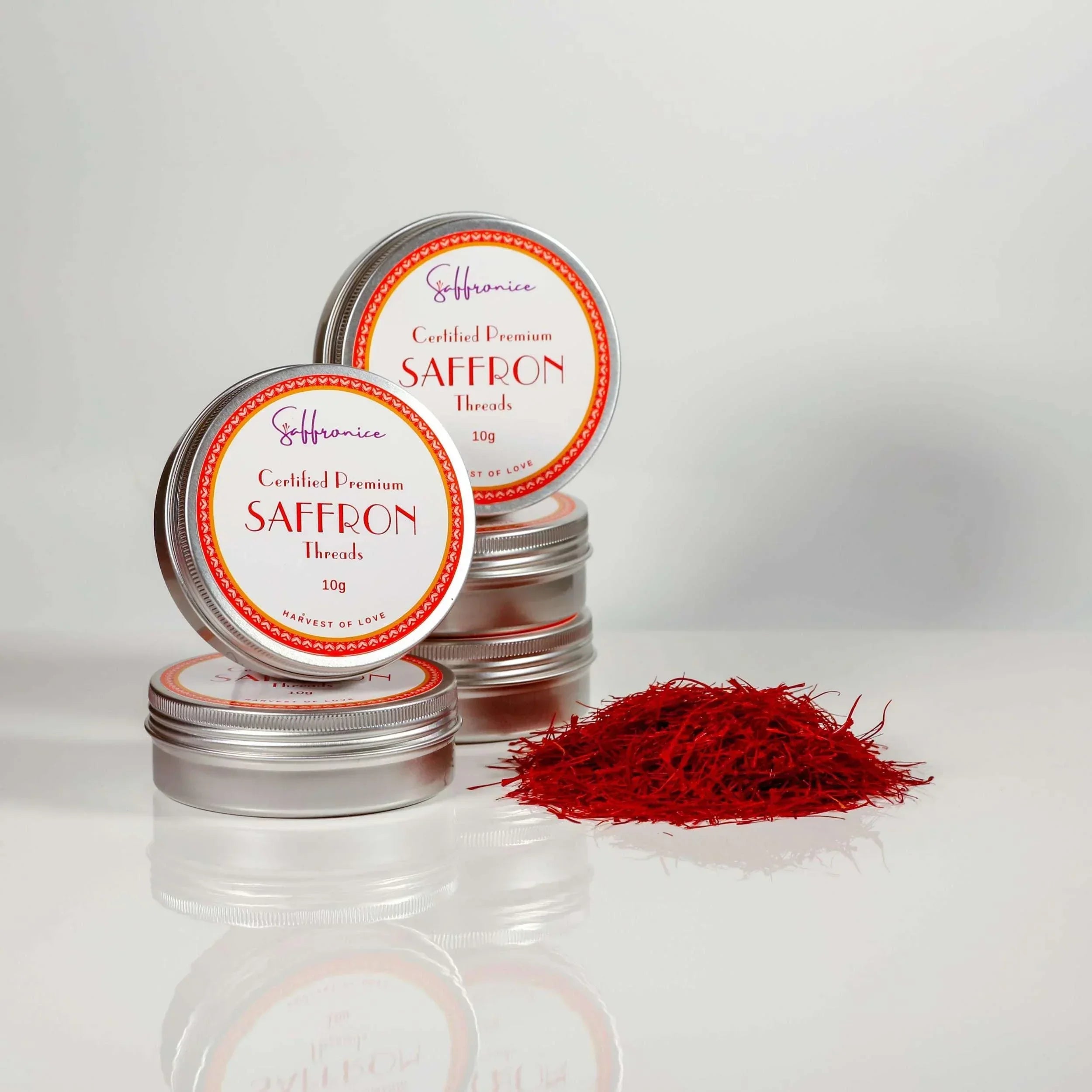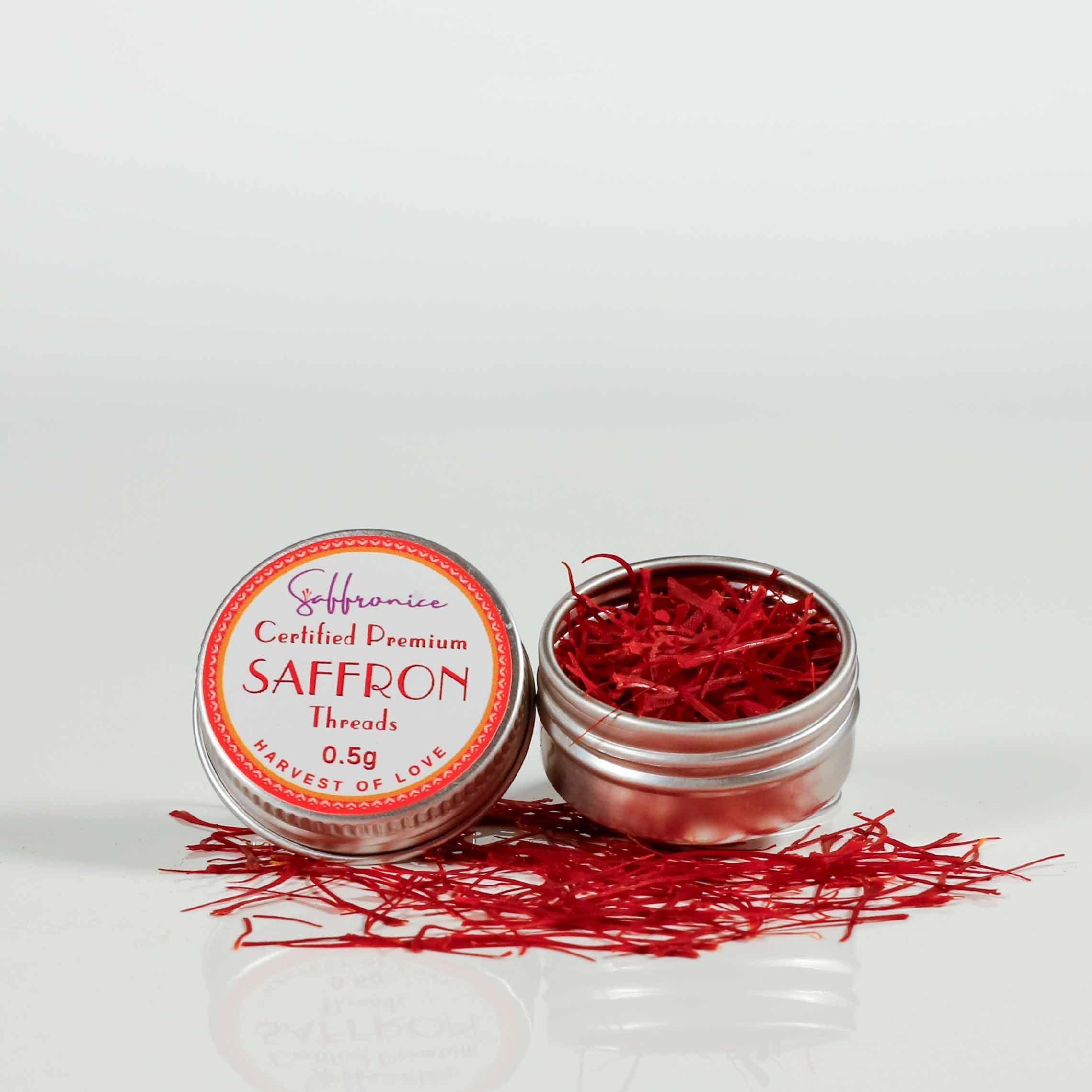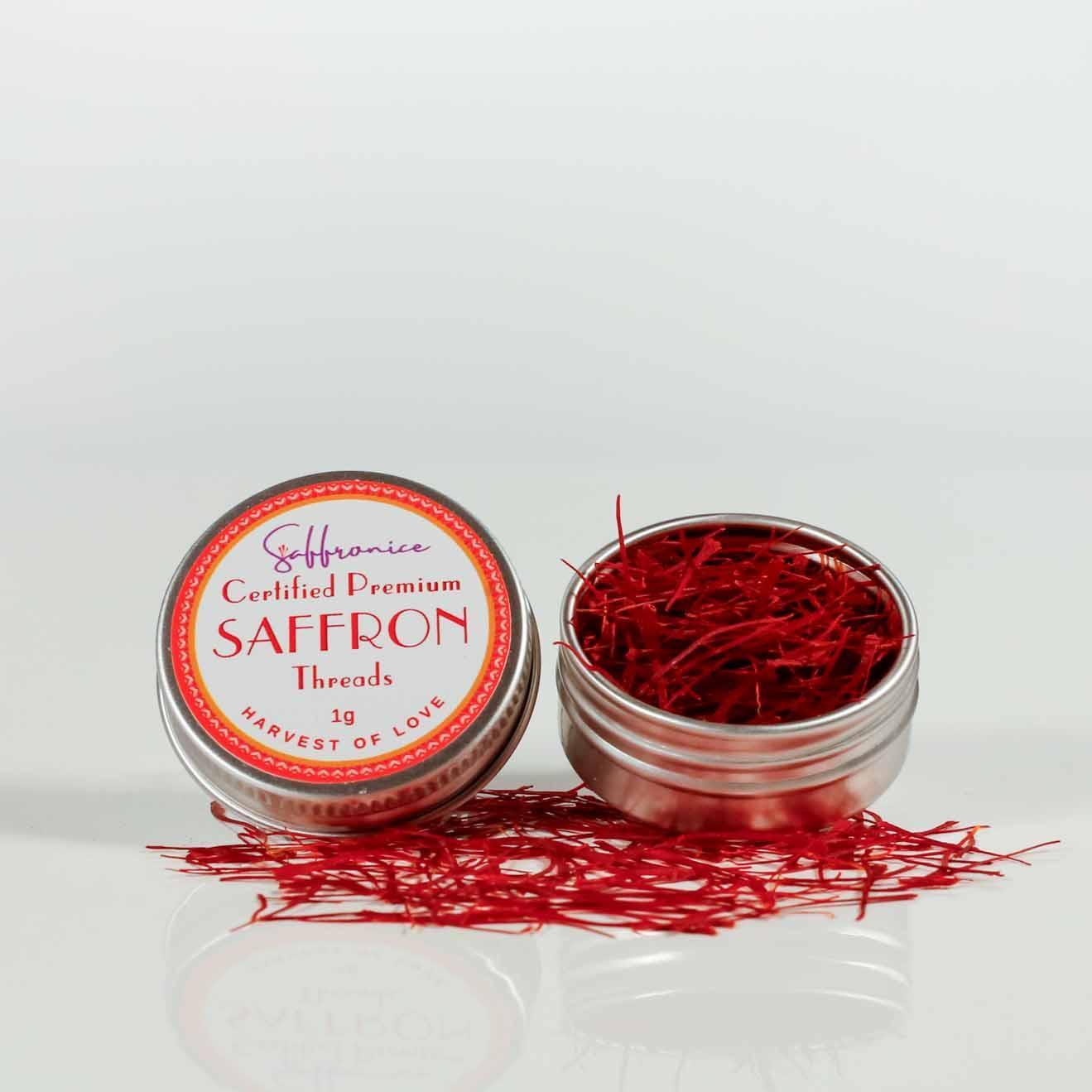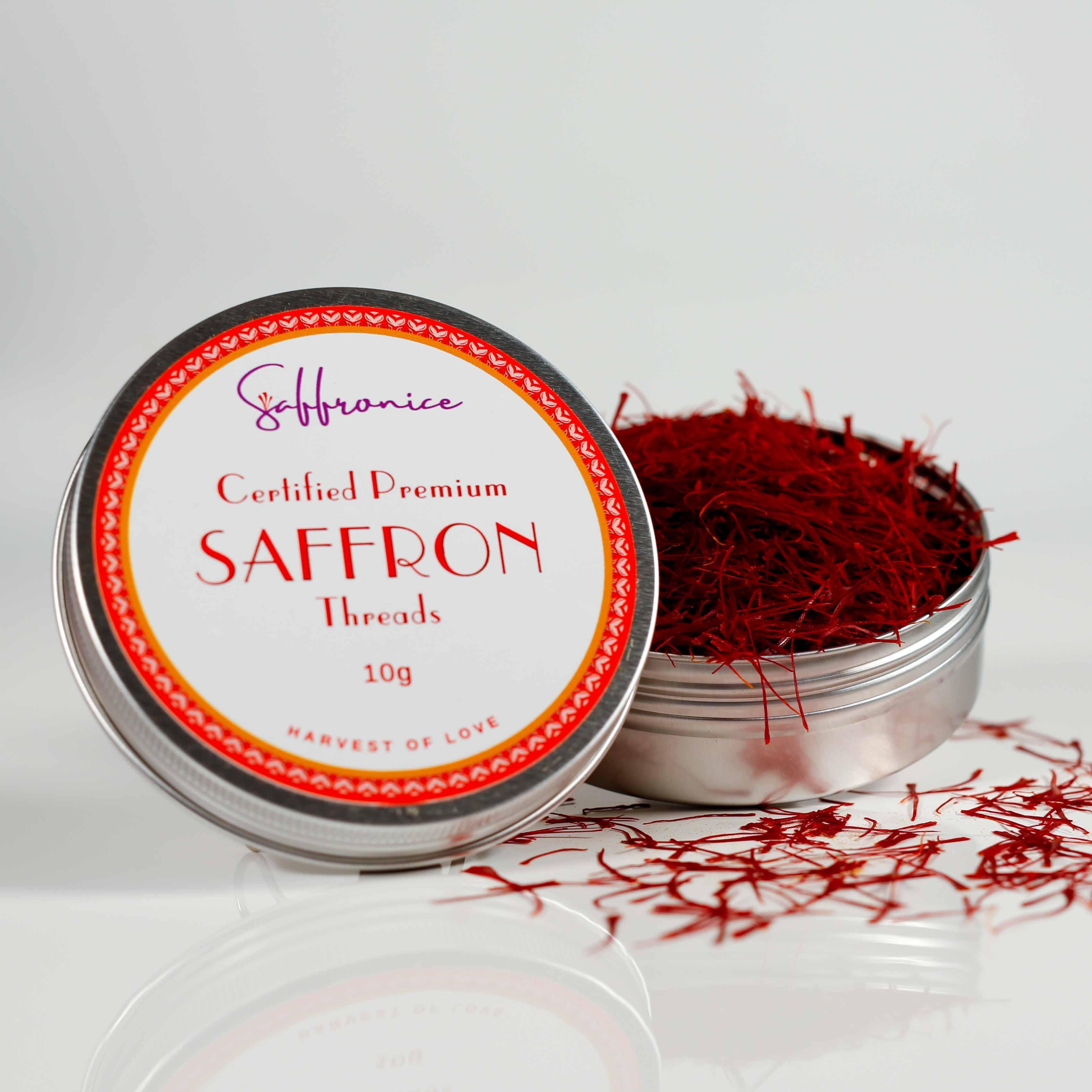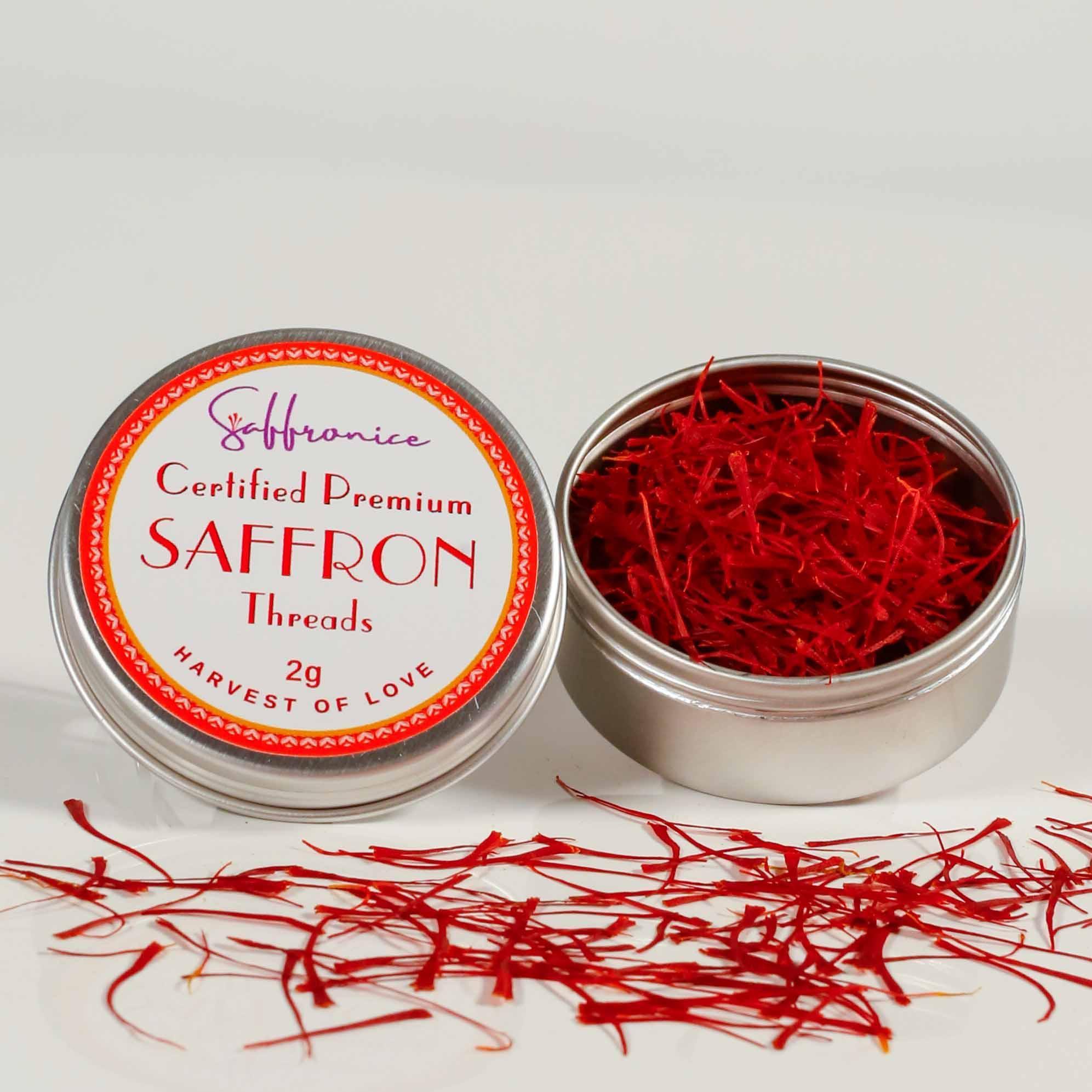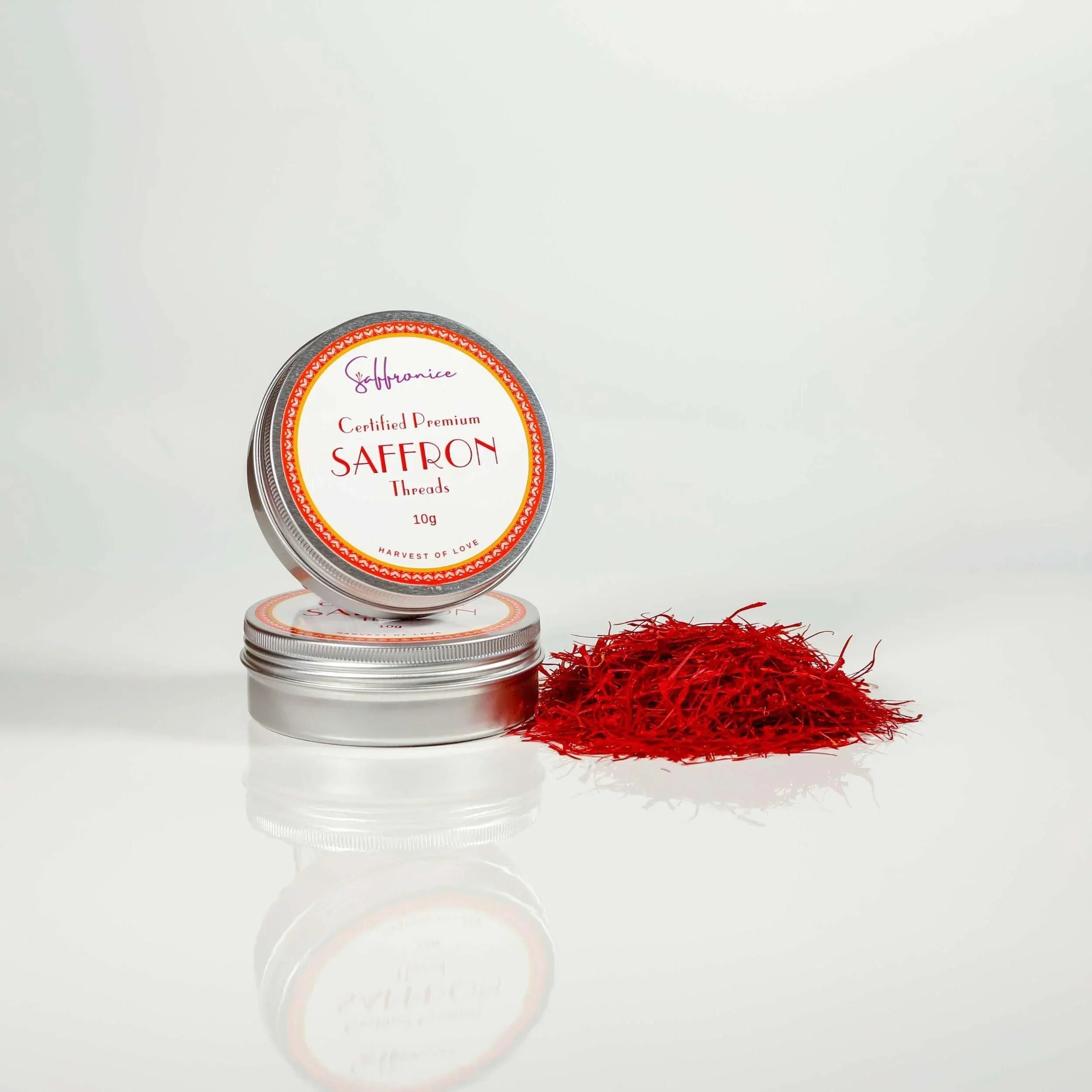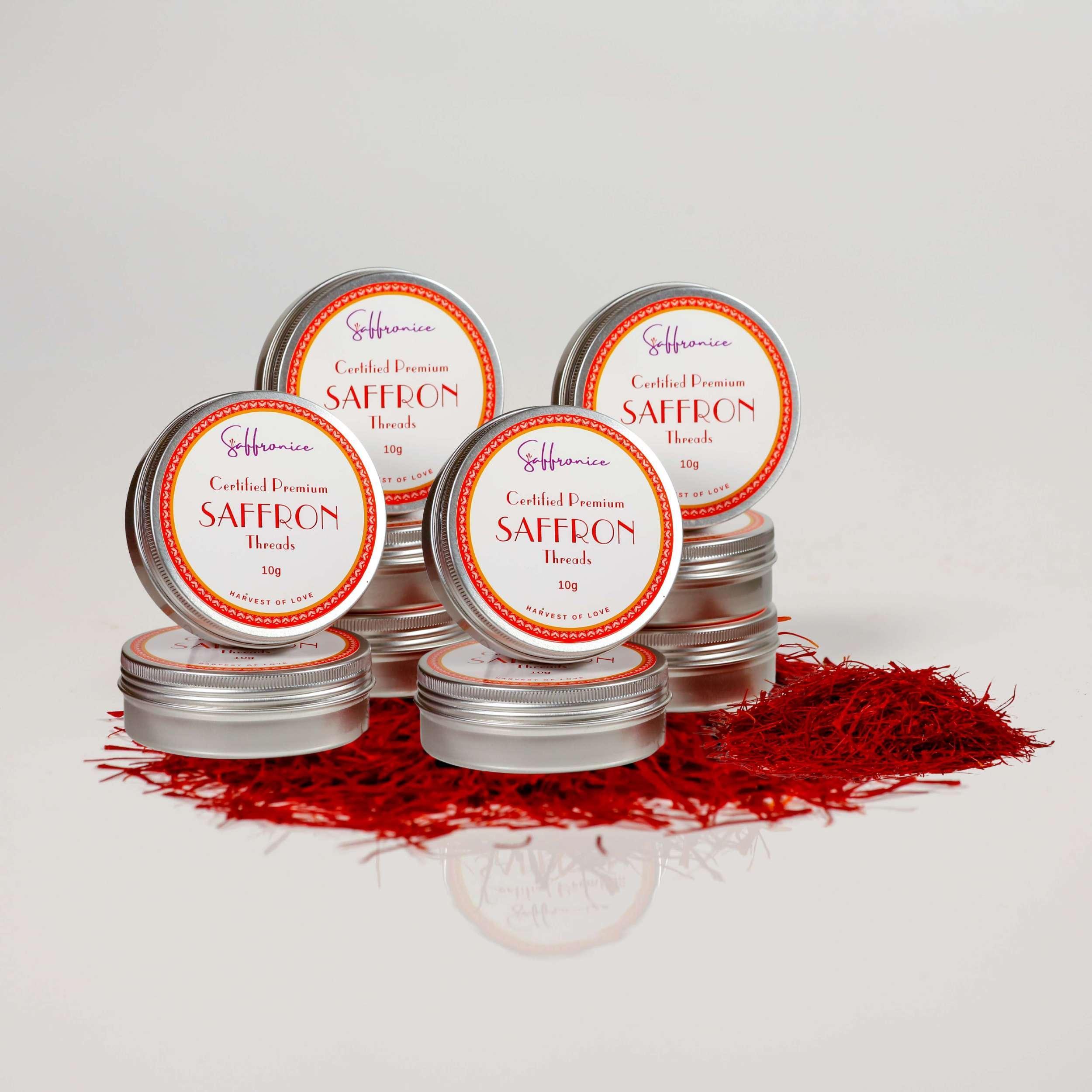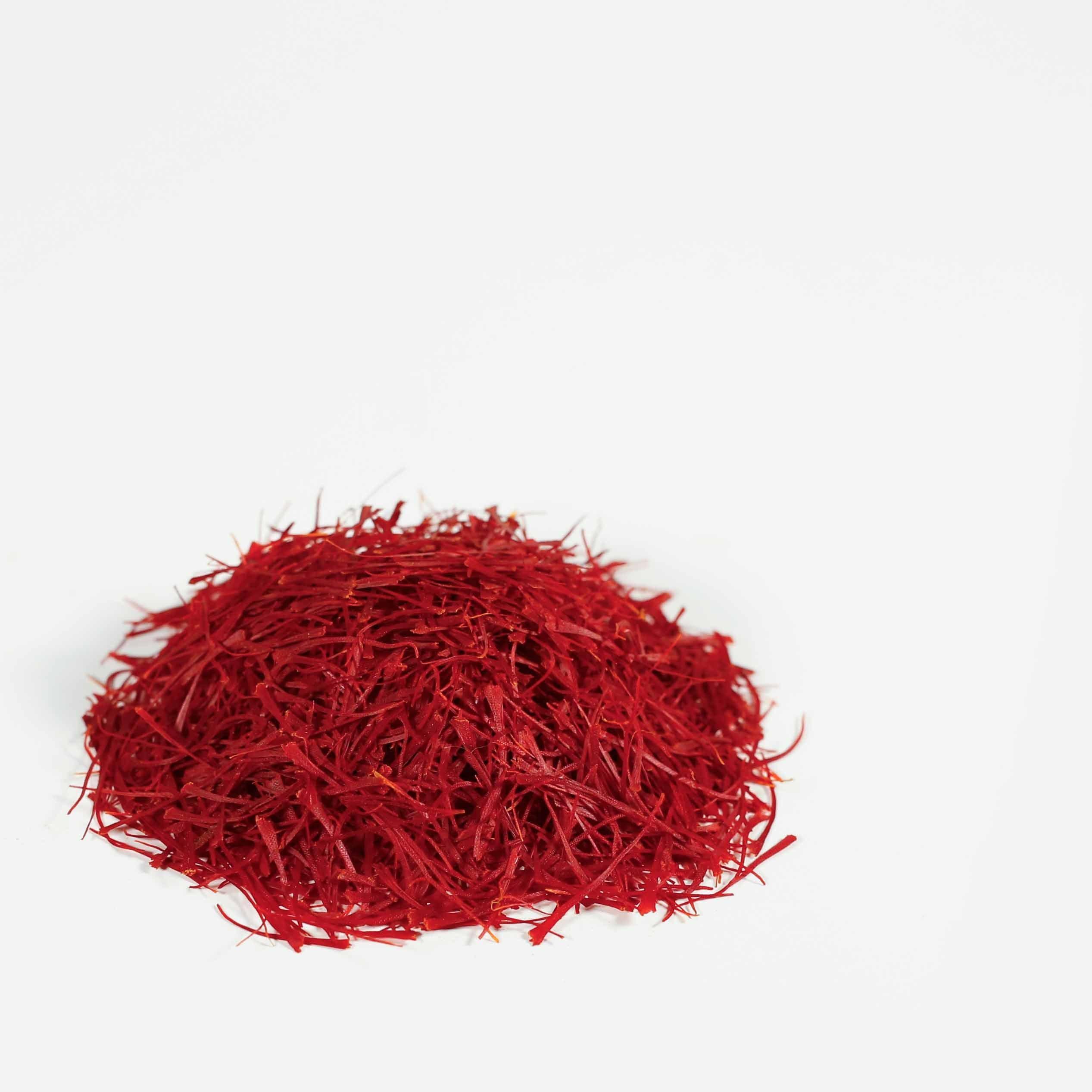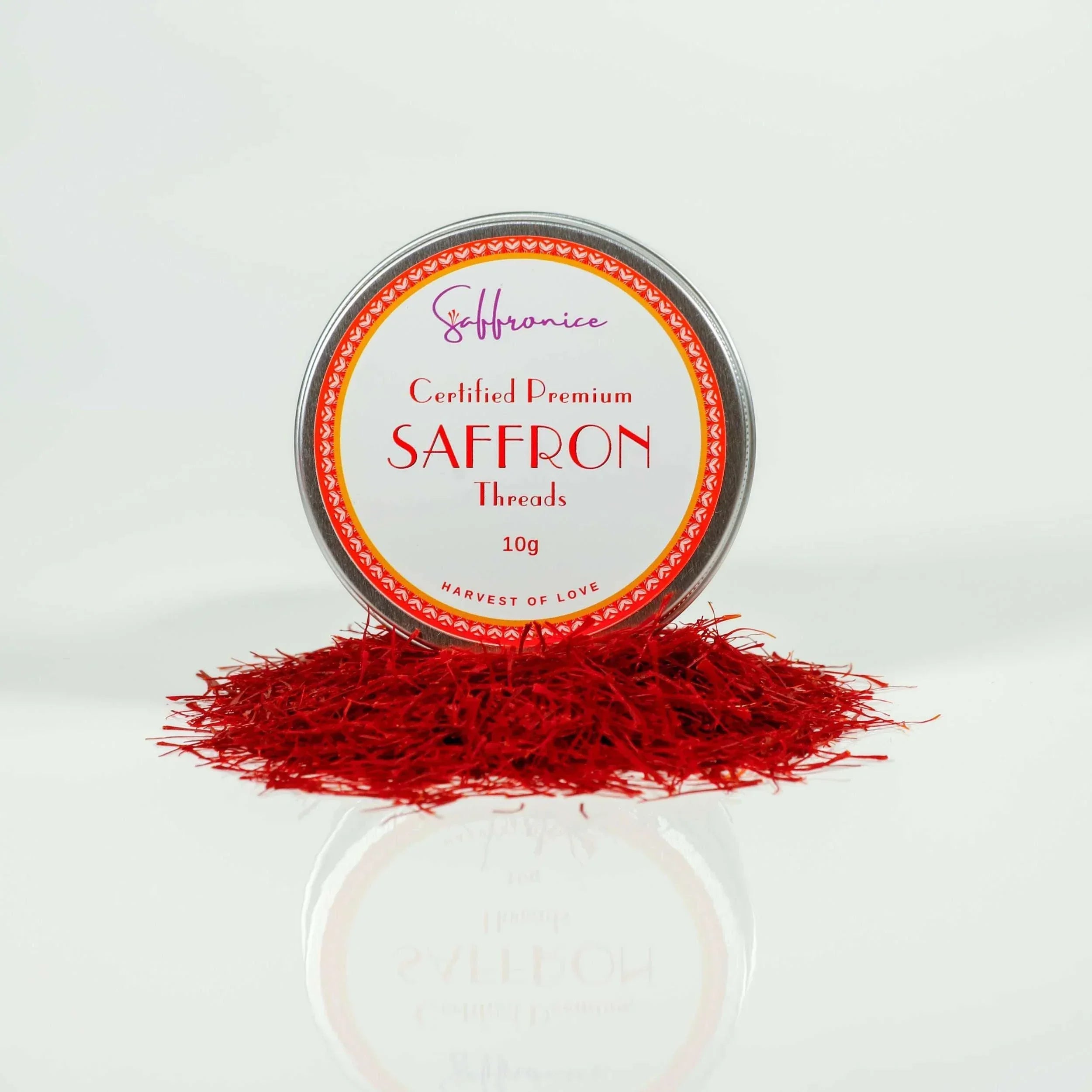Saffron and turmeric are two popular spices celebrated for their distinct flavors and versatile uses in cooking. Saffron, derived from the flower of Crocus sativus, boasts a delicate floral taste that enhances dishes like risottos and paellas. Turmeric, on the other hand, comes from the rhizome of Curcuma longa and offers an earthy warmth perfect for curries and golden milk lattes.
Understanding the nutritional differences between saffron and turmeric is crucial for making informed choices about their potential health benefits. Both spices bring unique qualities to the table, from antioxidants to anti-inflammatory properties. In fact, there are significant differences between saffron and turmeric, which can be important for both culinary and medicinal uses(Milajerdi et al., 2020).
In this article, we'll dive deep into:
- Nutritional profiles
- Health benefits
- Culinary applications
- Cost considerations
- Skincare properties
- Harvesting methods
- Traditional medicine uses
- Weight loss potential
- Flavor profiles
By exploring these aspects, you'll be well-equipped to decide which spice suits your needs best.

1. Nutritional Differences Between Saffron and Turmeric
Understanding the nutritional profiles of saffron and turmeric can help you appreciate their unique benefits.
Saffron Nutrition:
- Vitamins: Rich in B complex vitamins like B1 (thiamine), B2 (riboflavin), and B6 (pyridoxine). It also contains folate, vitamin C, and vitamin K.
- Minerals: Notably high in magnesium and iron.
- Antioxidants: Abundant in crocin and safranal, which contribute to its vibrant color and potential mood-enhancing effects.
- Caloric Content: Low in calories, making it a lightweight addition to your diet.
Turmeric Nutrition:
- Vitamins: Contains significant amounts of vitamin B5 (pantothenic acid), vitamin E, and vitamin K.
- Minerals: High in potassium and manganese.
- Active Compound: Curcumin, which is well-known for its anti-inflammatory properties(Hewlings & Kalman, 2017).
- Caloric Content: Slightly higher calorie content compared to saffron but still relatively low overall.
Both spices offer a wealth of beneficial nutrients, yet they differ significantly. Saffron's strong antioxidant profile makes it particularly valuable for combating oxidative stress, while turmeric's curcumin provides potent anti-inflammatory effects. Whether you’re seeking to enhance your diet with essential vitamins or looking for specific health benefits, understanding these differences can guide your choice between these two remarkable spices.

2. Health Benefits: Which Spice Reigns Supreme?
Health Benefits of Saffron
Saffron, often referred to as the "golden spice," is celebrated for its mood-enhancing effects. Studies have shown that saffron may help alleviate symptoms of depression and anxiety. This is largely attributed to its active compounds, crocin and safranal, which have demonstrated potential in boosting serotonin levels in the brain.
- Mood Enhancement: Research indicates that saffron can significantly improve mood disorders. It has been compared to conventional antidepressants with promising results.
- Weight Management: Saffron might also aid in appetite control and weight management. By reducing cravings and promoting satiety, it can be a helpful tool for those looking to manage their weight more effectively.
Health Benefits of Turmeric
Turmeric's claim to fame lies in its potent anti-inflammatory properties, thanks to the active compound curcumin. This vibrant yellow spice has been extensively studied for its wide-ranging health benefits.
- Anti-inflammatory Effects: Curcumin is known for its ability to fight inflammation, which plays a critical role in many chronic diseases. Regular consumption of turmeric can help reduce inflammation-related symptoms.
- Disease Prevention: There is evidence suggesting that turmeric may lower the risk of chronic diseases such as heart disease and certain cancers. Its antioxidant properties combat oxidative stress, which is a major contributor to these conditions.
Both saffron and turmeric offer impressive health benefits, each excelling in different areas. Whether you're looking to enhance your mood or combat inflammation, incorporating these spices into your diet could provide significant advantages.

3. Cooking with Saffron vs Turmeric: Flavor Profiles Unveiled
Saffron's Delicate Floral Notes
Cooking with saffron can elevate your dish with its unique and delicate floral flavor. Often described as slightly sweet and earthy, saffron is a staple in:
- Risottos: A classic example is Risotto alla Milanese, where saffron adds both flavor and a beautiful golden hue.
- Paellas: Essential in traditional Spanish paella, saffron imparts a depth of flavor that's hard to replicate.
- Desserts and Soups: Saffron's subtlety also makes it perfect for luxurious desserts or flavorful broths.
Despite its exceptional culinary value, saffron can be quite expensive due to the labor-intensive process of hand-harvesting the stigmas from crocus flowers.
Turmeric's Earthy Warmth
Turmeric, known for its earthy and slightly bitter taste, brings an entirely different dimension to dishes. Its versatility shines in:
- Curries: A key ingredient in many Indian and Middle Eastern curries, turmeric combines well with other spices for rich, complex flavors.
- Golden Milk Lattes: Popular in wellness circles, these lattes blend turmeric with milk (or milk alternatives) for a soothing drink.
- Savory Dishes: From roasted vegetables to rice dishes, turmeric's warmth complements a wide array of ingredients.
One practical note—cooking with turmeric can sometimes lead to stained surfaces or clothing, so handle it carefully.
Choosing Between Saffron and Turmeric
When comparing saffron vs. turmeric in terms of cooking applications:
- Cost Considerations: Saffron or turmeric—which is more expensive? Saffron takes the prize here, often costing significantly more due to its intricate harvesting process.
- Flavor Impact: While saffron offers a delicate floral profile perfect for certain high-end dishes, turmeric provides an earthy warmth that suits everyday cooking.
Both spices have their unique places in the kitchen. Whether you're making an exquisite risotto or a comforting curry, knowing when to use saffron vs. turmeric can make all the difference.

4. Cost Comparison: Is Saffron Worth the Splurge?
Understanding the cost of saffron vs turmeric is crucial for both home cooks and culinary enthusiasts. Saffron is known as one of the most expensive spices globally. This high cost stems from its labor-intensive production process. Each saffron thread is hand-harvested from the delicate stigmas of crocus flowers, a meticulous task that requires around 150 flowers to produce just one gram of saffron.
In contrast, turmeric offers an affordable alternative. Turmeric rhizomes are harvested from the ground and processed into various forms, such as powdered or fresh. This ease of production contributes to turmeric's lower price point, making it widely accessible and budget-friendly.
Key Points:
- Saffron:
- High cost due to labor-intensive hand-harvesting
- Requires approximately 150 crocus flowers for one gram
- Turmeric:
- Relatively inexpensive
- Widely available in multiple forms (powdered, fresh)
Investing in saffron can elevate your dishes with its unique flavor and vibrant color, but turmeric provides a cost-effective option without sacrificing versatility in the kitchen.
5. Skincare Benefits: Can These Spices Work Wonders for Your Skin?
Skincare Benefits of Saffron
Saffron's antioxidant-rich nature makes it a powerhouse for skin health. When used topically, saffron can:
- Brighten the complexion: Its antioxidants help to reduce pigmentation and dark spots, providing a more radiant appearance.
- Reduce signs of aging: The high levels of antioxidants combat free radicals, which can minimize fine lines and wrinkles.
Incorporating saffron into face masks or serums can offer these benefits, making it a sought-after ingredient in luxury skincare products.
Skincare Benefits of Turmeric
Turmeric's primary skincare benefit stems from its potent anti-inflammatory properties. This attribute makes turmeric beneficial for:
- Soothing irritated skin: Conditions like acne or eczema can be alleviated with turmeric due to its calming effects on inflammation.
- Healing properties: It promotes wound healing and reduces scarring.
However, turmeric should be used cautiously as it has a strong yellow pigment that can stain the skin and other surfaces. It's often included in DIY face masks but requires careful handling to avoid unwanted coloration.
Both saffron and turmeric bring unique skincare advantages to the table. While saffron focuses on enhancing skin brightness and combating aging, turmeric excels in soothing irritation and accelerating healing processes.

6. Harvesting Methods: From Flower Fields to Culinary Delights
Saffron and turmeric harvesting methods are as distinct as their flavors and uses:
1. Harvesting Saffron:
- Meticulous and time-sensitive.
- Crocus sativus flowers bloom for just a few days each year.
- Each flower produces only three red stigmas, which are painstakingly picked by hand.
- Labor-intensive process contributes to saffron's high cost.
2. Harvesting Turmeric:
- Ground-based and lengthy.
- Turmeric rhizomes grow underground for around 8-10 months.
- Once matured, they are dug up, cleaned, boiled, dried, and then ground into powder.
- More accessible and affordable due to its less labor-intensive process.
These contrasting harvesting techniques contribute to the unique qualities of saffron vs. turmeric, making each spice special in its own right.

7. Traditional Medicine Uses: Ancient Wisdom Meets Modern Science
Both saffron and turmeric have rich histories in healing practices such as Ayurveda, where each is highly regarded for its specific medicinal benefits.
Traditional Medicine Uses of Saffron
- Mood Enhancement: Often used to alleviate symptoms of depression and anxiety.
- Digestive Health: Believed to help improve digestion and ease stomach issues.
- Aphrodisiac: Traditionally regarded as a natural aphrodisiac.
Traditional Medicine Uses of Turmeric
- Anti-inflammatory: Utilized to reduce inflammation and treat conditions like arthritis.
- Immune Support: Known for boosting the immune system and fighting infections.
- Detoxification: Employed in detoxifying the liver and improving overall liver health.
Both spices continue to be subjects of modern scientific research, validating many of their traditional medicinal uses.
8. Weight Loss Potential: Can These Spices Help You Shed Pounds?
When exploring the weight loss benefits of saffron and turmeric, it's essential to look at their unique properties and how they might support your goals.
Saffron's Weight Loss Benefits:
- Studies suggest that saffron may help reduce cravings for unhealthy snacks, which can lead to gradual weight loss.
- The active compounds in saffron, such as crocin and safranal, are believed to have mood-enhancing effects that could potentially reduce emotional eating.
- Saffron supplements have shown promise in small-scale studies, but more extensive research is necessary to confirm these findings.
Turmeric's Weight Loss Benefits:
- The key player in turmeric's weight loss potential is curcumin, known for its anti-inflammatory and antioxidant properties.
- Curcumin has been linked to improved metabolism, which can support healthy weight management.
- While curcumin supplements may aid in weight loss efforts, they should complement a balanced diet and exercise rather than being relied upon as a magic bullet.
Both spices offer promising avenues for supporting weight loss, yet it's crucial to approach them as part of a holistic lifestyle change rather than quick-fix solutions. Incorporating saffron and turmeric into your diet can be a flavorful way to enhance overall health while potentially aiding in weight management.

9. Spice Substitution Dilemma: Can You Swap One for Another?
Substituting saffron with turmeric isn't generally recommended due to their distinct flavor profiles. Saffron offers a delicate floral taste, while turmeric provides an earthy warmth. Swapping one for the other will result in a completely different taste experience, which might not suit all dishes.
Considerations:
- Flavor Impact: Saffron's subtlety is best for dishes like risottos and paellas, where its unique aroma can shine. Turmeric's robustness pairs well with curries and savory dishes.
- Coloration: Both spices impart vibrant colors—saffron a golden hue and turmeric a deep yellow—but this doesn't compensate for the flavor difference.
For those exploring new culinary adventures, experimenting with Saffron vs. Turmeric can offer exciting results. However, understanding their unique characteristics ensures your dish meets the intended flavor profile.
FAQs (Frequently Asked Questions)
What are the main nutritional differences between saffron and turmeric?
Saffron's nutrient profile includes B complex vitamins (B1, B2, B6), folate, vitamin C, vitamin K, magnesium, and iron. It is low in calories but high in antioxidants like crocin and safranal. In contrast, turmeric contains curcumin (its active compound) along with B vitamins (B5), vitamin E, vitamin K, potassium, and manganese. It has anti-inflammatory properties but may have a slightly higher calorie content than saffron.
Which spice offers more health benefits: saffron or turmeric?
Saffron is known for its mood-enhancing effects and potential role in weight management. Studies suggest it may improve symptoms of depression and anxiety while also aiding in appetite control. Turmeric's primary health benefit comes from its potent anti-inflammatory properties due to curcumin, which has been linked to a reduced risk of chronic diseases such as heart disease and cancer.
How do saffron and turmeric differ in culinary applications?
Saffron has a delicate floral flavor profile that adds depth to dishes like risottos or paellas; however, it can be quite expensive due to labor-intensive harvesting methods. On the other hand, turmeric offers an earthy warmth that pairs well with curries or golden milk lattes. It is more affordable but can stain surfaces easily.
Is saffron worth its high cost compared to turmeric?
Yes, saffron is one of the most expensive spices globally due to its labor-intensive production process involving hand-harvesting delicate stigmas from crocus flowers. In contrast, turmeric is relatively inexpensive and widely available in various forms (powdered or fresh).
What are the skincare benefits of using saffron and turmeric?
Saffron's antioxidant-rich nature makes it beneficial for brightening the complexion and reducing signs of aging when used topically in face masks or serums. Turmeric's anti-inflammatory properties can help soothe irritated skin conditions like acne or eczema but should be used cautiously due to its staining potential.
Can you substitute saffron with turmeric in recipes?
Due to their distinct flavor profiles, it's generally not recommended to substitute one spice directly for another unless you're looking for a completely different taste experience altogether.
References
- Hewlings SJ, Kalman DS. Curcumin: A review of its effects on human health. Foods. 2017;6(10):92. doi:10.3390/foods6100092
- Milajerdi A, Djafarian K, Hosseini B, Ghasemi E, Salehi-Abargouei A. The toxicity of saffron (Crocus sativus L.) and its constituents against normal and cancer cells. Journal of Nutrition & Intermediary Metabolism. 2020;21:100115. doi:10.1016/j.jnim.2018.100115


